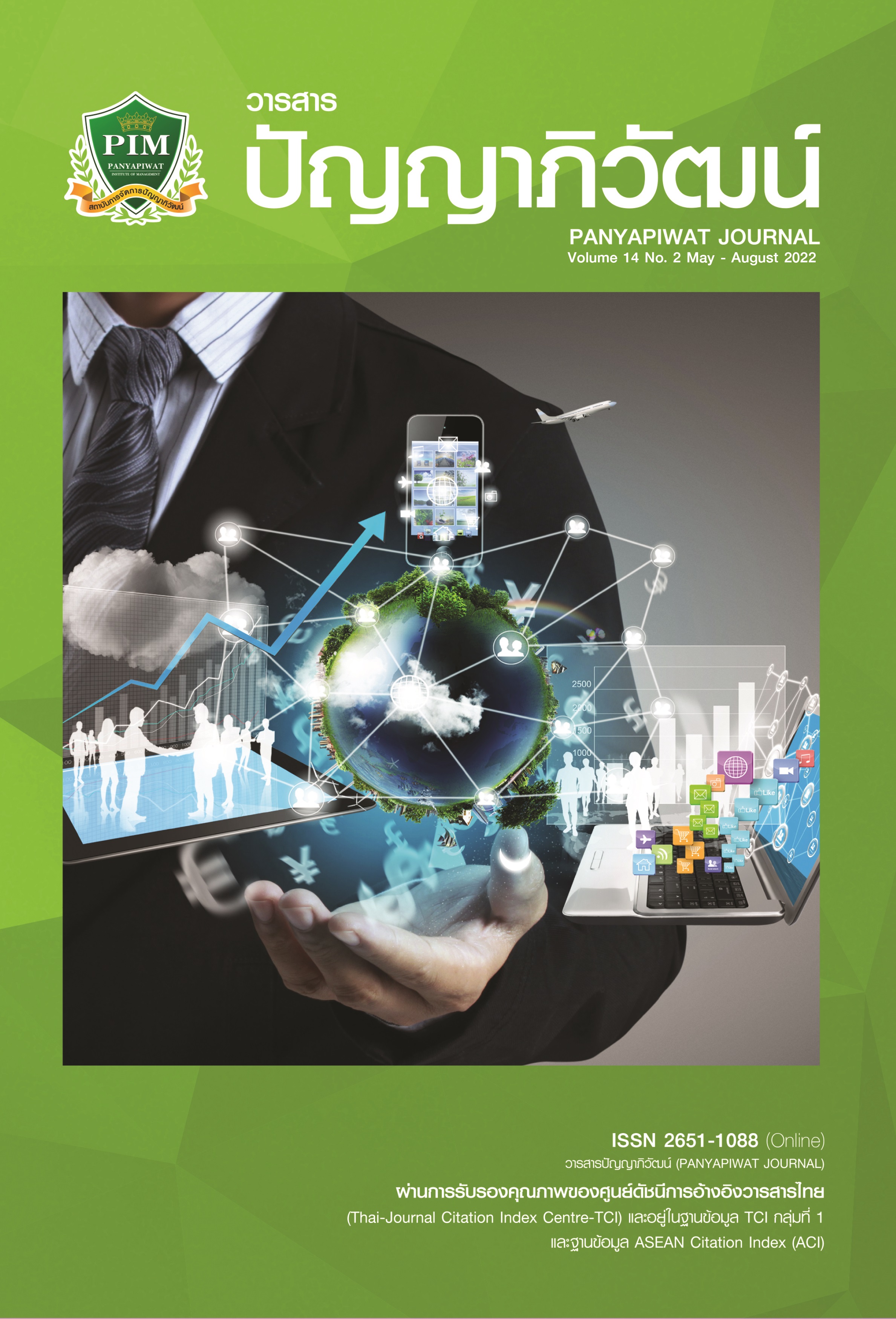ความคิดเห็นของกลุ่มคนรักเพศตรงข้ามที่เป็นพนักงานองค์การเอกชนและข้าราชการ ในเขตกรุงเทพมหานคร ในการสนับสนุนเพื่อนร่วมงานผู้มีความหลากหลายทางเพศ ให้สามารถจดทะเบียนคู่ชีวิตได้อย่างถูกต้องตามกฎหมาย
Main Article Content
บทคัดย่อ
กฎหมายการจดทะเบียนคู่ชีวิตมีเป้าหมายเพื่ออนุญาตให้บุคคลทุกคนสามารถมีคู่ชีวิต แม้ว่าจะเป็นคู่รักเพศวิถีที่แตกต่างจากธรรมเนียมปฏิบัติดั้งเดิมก็ได้รับสิทธิ์เท่าเทียมกันตามกฎหมาย ซึ่งส่งผลกระทบต่อองค์การทุกประเภท ผลการวิจัยครั้งนี้พบว่า กลุ่มคนรักเพศตรงข้ามที่เป็นพนักงานองค์การเอกชนและข้าราชการในเขตกรุงเทพมหานครแสดงความตั้งใจที่จะสนับสนุนเพื่อนร่วมงานผู้มีความหลากหลายทางเพศให้สามารถจดทะเบียนคู่ชีวิตอย่างถูกต้องตามกฎหมายในระดับค่อนข้างมาก จากอิทธิพลของตัวแปรอิสระ 2 ตัวแปร ได้แก่ ตัวแปรเจตคติต่อการสนับสนุนเพื่อนร่วมงานผู้มีความหลากหลายทางเพศให้สามารถจดทะเบียนคู่ชีวิตได้อย่างถูกต้องตามกฎหมาย และตัวแปรการคล้อยตามกลุ่มอ้างอิงทางสังคม แต่ไม่พบอิทธิพลจากตัวแปรการรับรู้ความสามารถในการควบคุมพฤติกรรม จึงอนุมานได้ว่ากฎหมายการจดทะเบียนคู่ชีวิต อาจเพียงแค่ทำให้กลุ่มคนรักเพศตรงข้ามแสดงความคิดเห็นเชิงบวกต่อการสนันสนุนเพื่อนร่วมงานผู้มีความหลากหลายทางเพศให้สามารถจดทะเบียนคู่ชีวิตได้อย่างถูกต้องตามกฎหมาย แต่ไม่มีผลในทางปฏิบัติ สรุปสมการความสัมพันธ์ คือ การสนับสนุนเพื่อนร่วมงาน ผู้มีความหลากหลายทางเพศให้สามารถจดทะเบียนคู่ชีวิตได้อย่างถูกต้องตามกฎหมาย = 2.372 + 0.789 (การคล้อยตามกลุ่มอ้างอิงทางสังคม) –0.273 (เจตคติต่อ พรบ.จดทะเบียนคู่ชีวิต) ซึ่งมีอำนาจในการพยากรณ์ประมาณ ร้อยละ 13.50
Article Details

อนุญาตภายใต้เงื่อนไข Creative Commons Attribution-NonCommercial-NoDerivatives 4.0 International License.
“ข้าพเจ้าและผู้เขียนร่วม (ถ้ามี) ขอรับรองว่า บทความที่เสนอมานี้ยังไม่เคยได้รับการตีพิมพ์และไม่ได้อยู่ระหว่างกระบวนการพิจารณาลงตีพิมพ์ในวารสารหรือแหล่งเผยแพร่อื่นใด ข้าพเจ้าและผู้เขียนร่วมยอมรับหลักเกณฑ์การพิจารณาต้นฉบับ ทั้งยินยอมให้กองบรรณาธิการมีสิทธิ์พิจารณาและตรวจแก้ต้นฉบับได้ตามที่เห็นสมควร พร้อมนี้ขอมอบลิขสิทธิ์บทความที่ได้รับการตีพิมพ์ให้แก่สถาบันการจัดการปัญญาภิวัฒน์หากมีการฟ้องร้องเรื่องการละเมิดลิขสิทธิ์เกี่ยวกับภาพ กราฟ ข้อความส่วนใดส่วนหนึ่งและ/หรือข้อคิดเห็นที่ปรากฏในบทความข้าพเจ้าและผู้เขียนร่วมยินยอมรับผิดชอบแต่เพียงฝ่ายเดียว”
เอกสารอ้างอิง
Ajzen, I. (1991). The theory of planned behavior. Organizational Behavior and Human Decision Processes, 50(2), 179-211.
Ajzen, I. (2012). The theory of planned behavior. In P. A. M. Lange, A. W. Kruglanski, & E. T. Higgins (Eds.), Handbook of theories of social psychology (p. 1). Sage.
Ajzen, I., & Sheikh, S. (2013). Action versus inaction: Anticipated affect in the theory of planned behavior. Journal of Applied Social Psychology, 43(1), 155-162.
American Psychological Association. (2012). Guidelines for psychological practice with lesbian, gay, and bisexual clients. American Psychologist, 67(1), 10-42.
Boonyadech, P. (2020). Civil partnership bill. COJ. https://rabi.coj.go.th/th/file/get/file/20200825e4b00b4a65a415cf9ebaa9f83-719c071115301.pdf [in Thai]
Clarke, V., Ellis, S. J., Peel, E., & Riggs, D. W. (2010). Lesbian gay bisexual trans and queer psychology. Cambridge University Press.
Fingerhut, A. W., Riggle, E. D. B., & Rostosky, S. S. (2011). Same-sex marriage: The social and psychological implications of policy and debates. Journal of Social Issues, 67(2), 225-241.
International Labour Organization. (2015). The promotion of LGBT human rights in the workplace. The International Labour Organization.
Jackson, P. A., & Cook, N. M. (1999). Gender & sexualities in modern Thailand. Silkworm Books.
Kraisri, T., & Patmanee, P. (2019). Organizational climate and job satisfaction of office workers with various gender identities in Bangkok metropolitan region. Journal of Business Administration and Social Sciences Ramkhamhaeng University, 2(3), 109-120. [in Thai]
Kuzelewska, E. (2019). Same-sex marriage-A Happy end story? The effectiveness of referendum on same-sex marriage in Europe. Bialostockie Studia Prawnicze, 24(1), 13-17.
Manalastas, E. J., Ojanen, T. T., Torre, B. A., Ratanashevorn, R., ZHong, B. C. C., & Kumaresan, V. (2017). Homonegativity in Southeast Asia: Attitude toward lesbians and gay men in Indonesia, Malaysia, the Philippines, Singapore, Thailand, and Vietnam. Asia-Pacific
Social Science Review, 17(1), 25-33.
Morales, M. (2019). Can family characteristics influence the future labor situation of children? Evidence for Spain. International Journal of Social Economics, 46(10), 1214-1233.
National Statistical Office. (2018). The labor force survey whole kingdom: February 2018. National Statistical Office, Ministry of Digital Economy and Society. [in Thai]
Ng, E. S., & Rumens, N. (2017). Diversity and inclusion for LGBT workers: Current issues and new horizons for research. Canadian Journal of Administrative Sciences, 34(2), 109-120.
Office of the Civil Service Commission. (2018). Government workers 2018: Civil servant. Information and Communication Technology Center. [in Thai]
Ozeren, E. (2014). Sexual orientation discrimination in the workplace: A systematic review of literature. Procedia-Social and Behavioral Science, 109, 1203-1215.
Panudecha, J., Boonpakdee, N., & Jaidee, T. (2007) Reproductive health rights the heart of women’s health. Sri Muang Publication. [in Thai]
Pinyo, T. (2018). Techniques for interpreting the results of factor analysis in research work. Panyapiwat Journal, 10(Special), 292-304.
Pongwichai, S. (2015). Statistics data analysis by computer. Chulalongkorn University Printing House. [in Thai]
Scherpe, J. M. (2013). The legal recognition of same-sex couples in Europe and the role of European court of human rights. The Equal Rights Review, 10, 83-96.
Terapachalaphon, C., & Kudngaongarm, P. (2017). Marriage equality rights for sexual diversity people in Thailand. Journal of the Association of Researchers, 22(2), 92-104. [in Thai]
UNDP & USAID. (2014). Being LGBT in Asia: The Thailand country report. UNDP & USAID.
Vanichbuncha, K. (2012). Application of SPSS for windows in the statistic analysis. Thammasarn Co., Ltd.
Webster, J. R., Adams, G. A., Maranto, C. L., Sawyer, K., & Thoroughgood, C. (2017). Workplace contextual supports for LGBT employees: A review, meta-analysis, and agenda for future research. HR Science Forum: Human Resource Management, 57(1), 193-210.
Yamane, T. (1967). Statistics: An introductory analysis (2nd ed.). Harper and Row.


